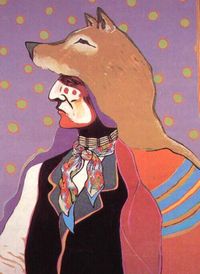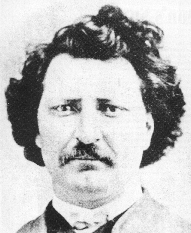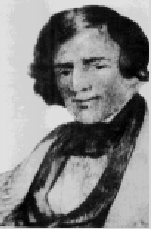Characters of the Frontier


The legacy of the American and Canadian frontier, as any frontier,was shaped by the individuals that had the priveledge to experience it. These individuals are at the center of the heritage the frontier forged and the stories we tell ourselves of this long vanished frontier.
The story of this frontier has been told an endless amount of times by many different perspectives. We hope you can appreciate from our perspective, this wonderful and interesting time in our history.
The Metis
The Settler
Indians and the White Man
The Mountain Man
 Although little known to most, the Metis play a major role in the
story of the North American frontier. In fact, like the story of the
early American settlers surviving thanks to help from the natives, early
clerks and managers imported by the Hudson Bay Company would not have
survived without the help of the Metis. Metis is the French word for
mixed. The Metis are indeed a mix, the product of a close relationship
between the French voyageurs and Indians of the area. Since both Native
Americans and more recently Europeans migrated to the Americas, an
argument can be made that the Metis are the only true aboriginal peoples
of the Americas.
Although little known to most, the Metis play a major role in the
story of the North American frontier. In fact, like the story of the
early American settlers surviving thanks to help from the natives, early
clerks and managers imported by the Hudson Bay Company would not have
survived without the help of the Metis. Metis is the French word for
mixed. The Metis are indeed a mix, the product of a close relationship
between the French voyageurs and Indians of the area. Since both Native
Americans and more recently Europeans migrated to the Americas, an
argument can be made that the Metis are the only true aboriginal peoples
of the Americas.Probably the most influential figure in Metis history, Louis Riel spent his life dedicating himself to the service of his people. Considered a martyr and hero by his brethren and a traitor by his government, his legacy lives on today, one hundred years after his execution by the Canadian government.
Riel was born on the Red River Settlement (today Manitoba) on October 22, 1844 to strict Catholic parents, Louis Riel Sr. and Julie Lagimodiere. Religion played an important role in Riels upbringing. With hopes of entering the clergy, at fourteen he was sent away to Montreal to attend the College de Montreal where he began an eight year classical studies program. It didnt take him long to gain the highest ranking of his class. However, following the news of his fathers death, Riels attitude towards school changed. His instructors questioned his religious conviction and change of behavior. Apparently fed up with the restrictiveness of the College de Montreal he decided to leave and continue his schooling as a day student while living with the Grey Nuns. However, after breaking too many rules and missing classes, he was asked to leave the College and the convent. He moved in with his aunt, Lucie Riel and found employment in a law office.
Canadian politics were turned upside down at this time. With a strong education and a knowledge of Canadian law, to say Riel was an asset to the Metis at this critical point in their history would be an understatement. In 1869 the Hudson Bay Company planned on selling Ruperts Land (present day Manitoba) to Canada as of December 1. This left a void of jurisdiction in the territory for approximately four months. To save any prospects of sovereignty that the Metis had, Riel, being shrewd in the ways of the law would have to set up a provisional government to keep Canada or the United States from annexing the Red River area and subsequently squashing any legal rights of the Metis to their lands as well as their way of life. Unknowingly strengthening Riels motivation to create a provisional government, the Canadian government sent out surveyors and road builders to plot the Metis homeland before December 1, therefore doing so with no jurisdiction. It was here that Riel established himself as a leader and won the hearts of his followers when on October 11, 1869, he and sixteen of his followers stopped a trespassing government survey crew on land belonging to his cousin, Andre Nault. This was the beginning of the resistance. With freedom hanging in the balance, Riel and 120 of his followers sacked Fort Garry drawing attention from the government. Stopping only to fly the flag, Riel set up his revolutionary government, which turned out to be ironically more democratic then the Canadian government. He drew up a List of Rights and negotiated for Manitobas admittance to the Confederacy.
His List of Rights included:
Out of fear for his own life, Riel fled to the United States and would not return to Manitoba again until 1883. During his exile Riel slipped in and out of depression. He was treated in an asylum in Quebec for two years. It was during these times that he increasingly began to receive Divine intervention that led him to believe that he was the prophet for the Metis and he was sent to lead them. This drove him back home to Manitoba. However, nothing there interested him anymore so he moved to Battoche, Saskatchewan in 1884. The Metis and Indian groups in the area were suffering through a horrible winter full of disease and starvation and being a minority, they needed him to present their grievances to the government. The federal government, evidently forgetting Riels influence and resolve, ignored the Metis and their demands and instead of sending food, Prime Minister John A. McDonald sent in police. This led Riel to form his second provisional government. However, in the spring, the Metis with Indian groups, notably the Cree and Stoney Indians staged the 1885 Rebellion against the Canadian government. Out manned and out gunned, the rebels were quickly subdued by the government police and army forces. Lasting only a month, the Rebellion marked the end for Riel. He was democratically sentenced to death by a jury of six English speaking Protestants and on November 16, 1885 he was hanged for treason. Throughout the two week trial, Riel repeatedly turned down the urgings of his lawyer to plead not guilty by insanity. Although he possibly could have been saved with his history of being a patient in an insane asylum, he chose death.
With Riel's legacy we are left with the foundations for any great nation to be built upon, those being the rights and freedoms he died for.
Copyright 1999 Bryan J. Freyberg, All rights reserved.
Metis Families
More on Riel
Canadian Heroes
"These and many other writers attest to how men's masculinity and selfhood have been defined through their 'conquest' of the West. However, until the mid- 1970s, most scholars overlooked women's contributions during the western settlement period"(web site)
Woman settlers have been overlooked for years on end, and their stories have remained untold until recently. Women, as much as men, were essential in the taming of the West, and one of those women, Elinore Pruitt Stewart, portrayed the spirit of the woman settler.
Elinore Pruitt Stewart was born in 1876, in the Indian Territory, into a poor family life. When she was eighteen, her parents died, and because of this, her time was spent being a mother to her siblings. She eventually married and had a child of her own, living a very normal life. But in 1906, Elinore decided to leave her old life behind and follow her dream to become a homesteader. She left behind all that she knew: her home, her husband, and traded in the city life for the life of the settler. Elinore, a young, naive city woman, set aside her fears and dared to dream ; a dream of a better life. She made that dream a reality.
Although, Elinore was carrying out her dream, it was no easy task. When she left her old life behind, she left a safe, predictable, and stable life. When she endeavored to wrestle the frontier life, she no longer had a safe, predictable or stable life. The frontier life introduced Elinore to many hardships. Hard, physical labor, snowstorms, and the struggle to have a day's meal became a part of Elinore's everyday life. Elinore, a single mother and a woman living among mostly all men, showed much strength and courage in taking on such an adventurous life. But Elinore, like many other woman settlers, embraced humor, making the harsh, and often lonely , life of the frontier a little easier.
'I am a firm believer in laughter. I am real superstitious about it. I think if Bad Luck came along, he would take to his heels if some one laughed right loudly'. (Elinore Pruitt Stewart)
The adventures of Elinore Pruitt Stewart were many, and the frontier spirit she portrayed throughout her life is an inspiration to anyone who wants to follow their aspirations, and dare to dream. One can read excerpts of her life stories in" Letters of a Woman Homesteader", a book which contains letters written by Elinore herself. For those who would like to read more on her, Click Here
The settlers viewed the indians as a threat, not to thier culture, heritage, history, language or families, but to thier land. With the indians off the fertile soil(river valleys etc.) the settlers had more room to grow crops and cattle. With the spread of the white-man's diseases, the government was able to wipe out large numbers of indians , and then move the survivors to reservations.
The treaties made between the Indians and the United States and the Indians and Canada were a very big part of life for them. As we all know the majority of the treaties made between these three parties were either annulled or considered invalid when they were no longer acceptable to the U.S. or Canada.
One such treaty, the "Treaty of Peace and Friendship" turned out to be as hokey as the name suggests. This treaty was between the U.S. and the Hoopa, South Fork, Redwood and Grouse Creek Indians. At first the treaty sounded very feesible and it seemed that the U.S. would uphold it's end, then they started making rules. The land "given" to the indians was a chunk of the Hoopa Valley and the Trinity River bed. The United States agreed to provide a yearly supply of food, clothes and blankets as well as classes to help teach the squaws how to cook and sew clothing. A full time physician was also appointed to care for the indians. This all sounded very nice to the tribes involved but when they were settled on the reservation land, the U.S. introduced thier rules. The indians were not allowed to leave teh reservation without permission, any indian that did so would be considered hostile and fair game for bounty hunters. The second big condition was that the indians had to sell all thier guns and amunition to the army. This meant that they had no protection and if they wanted to hunt they had to ask permission of the "caretaker" to use a gun for a day. The reason for the rules was to keep the indians in one place, so that the government could keep tabs on them, and the second rule(no firearms) kept the indians from rebelling and put the men with guns(U.S. Army) into a more powerfull postion.
In between the years of 1785 and 1866 many treaties were made and broken between the U.S. and the Indians, here are just a few examples:
These tribes show just a very few examples of all the treaties made. Many more thousand treaties were made and broken. One of the last treaties broken with the Cherokee was the "Treaty with the Western Cherokee of 1833."
This treaty was almost identical to the one previously discussed, only the Cherokee recieved more land. But along with the land came laws and "surveyors." The laws were to keep the indians"in their place" and the surveyors were supposed to make sure that the indians all got a fair share. Shortly after the treatie was signed and the indians were moved onto the land, articles started to be annuled from the treatie.
The first to go was Article 6. It stated that the indians got 1
square mile to put an agency office on. Once the government figured out
that by giving the indians a meeting place they were giving them
solidarity, they dropped the article.
Details of the Treaty
 The search for freedom has brought many a man to venture to mountain life. Legends such as Jeremiah Johnson and Jedidiah Smith are such men who are instantly recognized for their journeys and triumphs while leading the mountain life. Not only was the mountain man an excellent hunter and trapper, he also broke the path through the mountains to the western United States. These great explorers discovered the passes and the trails that helped this great nation expand and prosper in the lands that awaited beyond the seemingly unpassable barrier of the Rocky Mountains.
The search for freedom has brought many a man to venture to mountain life. Legends such as Jeremiah Johnson and Jedidiah Smith are such men who are instantly recognized for their journeys and triumphs while leading the mountain life. Not only was the mountain man an excellent hunter and trapper, he also broke the path through the mountains to the western United States. These great explorers discovered the passes and the trails that helped this great nation expand and prosper in the lands that awaited beyond the seemingly unpassable barrier of the Rocky Mountains.
More importantly than physical discovery is what burned in the heart of every man that dared to venture on his own is search of a free life. This fire burns in the heart of any person who enjoys fishing, hunting, camping, or any activity in the wilderness. It is the fire of the human spirit, yearning to be free and alive. Nothing can top the feeling of life that one gets from being alone in the woods and simply taking in all that nature has to offer. It makes you feel proud, it makes you feel happy, and it makes you feel grateful to be alive on this great earth. The spirit of the mountain man is the one that keeps people searching for new ideas and striving to improve life. It lives in hearts of all and can only be held down by not knowing it is there. The spirit of the mountain man keeps man searching, it keeps man free, and it keeps man alive.
The legend of the mountain man lives on in all but his ways are still alive as well. There are many clubs and groups throughout the U.S. that dedicate themselves to the mountain man. They arrange wilderness rendezvous and study the ways of the great explorer. Below you will find links to some sites of these clubs. I encourage you to read what they have to say and let the mountain man inside you live on.
Mountian Man and The Fur Trade
 thowat@d.umn.edu
thowat@d.umn.edu